The above copper farthing token measures 15.5 mm in diameter and weighs 0.96 grams. On purely stylistic grounds it would appear to date from the 1650s. It was issued by Richard Harper, a tradesman operating from premises in West Smithfield, London. The design of the token may be formally described as follows;
Obverse: (mullet) RIC. HARPER. AT. THE. HARP around a depiction of a harp.
Reverse: (mullet) IN. WESTSMITHFIELD around a triad of initials comprising R | .H. | .A with a small dot below the “C”.
The triads of initials on the reverse of the token are those of its issuer, Richard Harper and his wife, Mrs. A. Harper.
The depiction of the harp on the token’s obverse almost certainly represents the trade sign which hung over Richard’s business premises in West Smithfield. Such signs often featured objects that were readily associated with a current or former premises holder’s occupation or trade. In this case the sign’s subject matter may have been purposely selected as being synonymous with the traders own surname (i.e. harp and Harper). This was not uncommon as illustrated by the following half-penny token of 1667. Its issuer was Bartholomew Fish, a fletcher, who operated from premises in Queenhithe and traded under the sign of three fish. Another obvious play on words based on the trader’s surname.
While the token mentions no particular street name for the location of Richard Harper’s premises its reverse legend does make it clear that it was in West Smithfield. This area, in the Ward of Farringdon Without, lay just north of the old city walls between New Gate and Alders Gate entrances to the city. Then as now it was the location of one of the city’s principal meat markets and the home to St. Bartholomew’s Hospital which, being founded in 1123, holds the title of Europe’s oldest hospital. West Smithfield lies just outside the north-western limits of that area of London which was destroyed by the Great Fire of 1666.
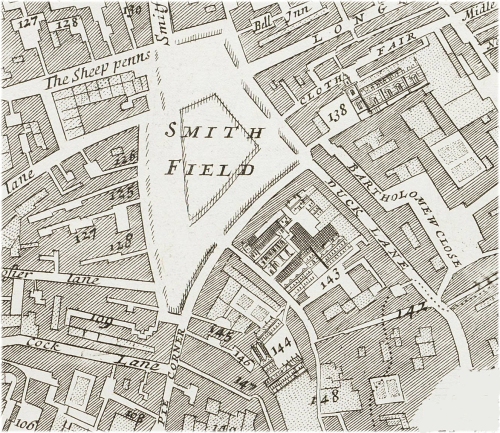
West Smithfield, London. (c.1720) showing the Parish church of St Bartholomew the Less (above Well Yard – No.144) and St Bartholomew’s Hospital (No.144)
The Search for Richard Harper of West Smithfield
From a review of contemporary parish registers, rent books, Hearth Tax returns and livery company records it has been possible to put together an outline history of the token issuer, Richard Harper, and his immediate family and business interests.
It is likely that Richard Harper was born c.1589 in Shropshire, England. In 1601 he most probably lived with his family in the small hamlet of Woolstaston, located in the northern foothills of the Long Mynd in Shropshire. He had at least two slightly younger brothers, William and Thomas. At that time his father was described as a yeoman (1) of Woolstaston. However, by 1604 his occupation was described variously as clerk (10th July) and later (25th July) as minister (2) so by then he may have been serving his local parish church, St. Michael and All Angels, Woolstaston.
On 31st January 1601/2 Richard was bound by his father as an apprentice for seven years to Raffe Newbery, a citizen of London and master of the Worshipful Company of Stationers (3).
The Stationers’ Company was formed in 1403 and received a Royal Charter in 1557. It held a monopoly over the publishing trade and was officially responsible for setting and enforcing regulations within the industry. It retained this power until 1710.
It is not known if the Harper family already had associations with the publishing and book selling trade prior to young Richard being bound as an apprentice stationer in 1601/2. However, the links to this trade were to grow stronger as in 1604 Richard’s father also bound both of his younger sons to London Stationers. Richard’s brother William was apprenticed to John Bill on 25th July 1604 for a period of eight years while his brother Thomas was bound to Melchisedeck Bradwood for a period of seven years on 29th September 1604 (4).
Before focusing on Richard Harper’s later life it is worthwhile mentioning a few details regarding the careers of his brothers William and Thomas.
Thomas Harper completed his apprenticeship and received his freedom in 1611. His brother William completed his apprenticeship in 1612 (5). By 1614 the two brothers are recorded as being in partnership and operating as book sellers and stationers from a shop in old St. Paul’s Cathedral Churchyard (6). The brothers registered their first publication title, a translation of “A Discourse on Parent’s Honour and Authority” with the Stationer’s Company (as a form of early copyrighting) on 1st July 1614 (7).
The area around St. Paul’s churchyard was arguably the principal focus of London’s book and pamphlet trade throughout the first half of the 17th century. Other areas of the city were also prominent including Little Britain, with its tributary Duck Lane, Paternoster Row and London Bridge. In 1663 the French traveller, Samuel de Sorbière, commented on London’s book trade as follows (8);
“I am not to forget the vast number of booksellers’ shops I have observed in London, for besides those who are set up here and there in the city, they have their particular quarters such as St. Paul’s Churchyard and Little Britain where there are twice as many as in the Rue St. Jacques in Paris, and who have each of them have two or three warehouses.”
By 1634 Thomas Harper appears to have parted company with his brother William and was trading as a printer from his house in Little Britain (9). What became of William after he left his partnership with Thomas is unclear.
In 1639 Thomas Harper was working as a printer with a new partner, Richard Hodgkinson (10). During the early years of the English Civil War it is reported that he got into trouble on more than one occasion for printing pamphlets against the Parliament (Polder), leading several writers to label him as having Royalist sympathies. Thomas Harper appears to have continued his trade as a printer until his death in March 1655/6 (11).
We now return to the subject of Richard Harper, the slightly older brother of Thomas and William. Richard was bound into a seven-year apprenticeship with a master London stationer in 1601/2 and as such it would be expected that he would have received his freedom in 1608/9. However, the transcribed records of the Worshipful Company of Stationers (12) only record two individuals by this name and they didn’t receive their freedoms until 6th May 1633 and 4th November 1634 respectively. It is possible that one of these same named entries could be a transcribing error but equally they may both be correct. Either way thereafter the transcribed records of the Stationers’ Company appear to ascribe all future references to Richard Harper as relating to that individual who gained his freedom in 1633.
The above observations raise the question as to whether the Richard Harper who received his freedom from the Stationers’ Company in 1633 was the same Richard Harper who was bound an apprentice stationer in 1601/2. A search for the records of an additional apprentice(s) by this name, who may have been bound as a stationer in the mid 1620s, has so far failed to identify anything. The inference of this is that the young Richard Harper who was bound as an apprentice stationer in 1601/2 was very likely the same man who finally received his freedom from the Stationers’ Company in 1633. If this is the case then Richard may have failed to complete his original seven-year apprenticeship and hence becoming a freeman of the city in 1608/9 which thereafter would have allowed him to officially practice as a London stationer. Failure for individuals to complete their apprenticeship during this period was not uncommon and could have resulted from one of numerous reasons including;
- The death of the apprentice’s master or the failure of his business.
- The mutual agreement between master and apprentice for them to part ways amicably.
- The ill-treatment of the apprentice by the master causing the latter to run away or seek formal termination of the apprenticeship via the Livery Company or Lord Major’s Court.
- A change in family circumstances causing the apprentice to return home, with or without attaining any new skills in his new trade, to assist/take-over the family business or take-up an inheritance. This may or may not have included him taking up practice in his new trade if living outside of the City of London.
Having failed to complete his apprenticeship in 1608/9 didn’t necessarily preclude Richard Harper from ever officially practicing as a stationer within the City of London. There were alternative ways of becoming a registered livery company member and taking up the position of a freeman of the city. These included;
- By being the son of a freeman.
- By marrying the widow or daughter of a freeman.
- By redemption, that is by paying a “fine” to buy the privilege.
For Richard Harper to have become a freeman of the city and a member of the Stationers’ Company in 1633 then one of the above conditions must have applied. As he was initially bound as an apprenticeship stationer in the city in 1601/2 by his father, a yeoman/minister of Shropshire, it can safely be assumed that Richard must have either married into or bought his freedom and hence membership of the Stationers’ Company.
The transcribed records of the Stationers Company list Richard Harper as an active publisher and printer between 1633 and 1640 (13) although publications dated as late as 1652 are known to have been published in his name. He registered his first book title “Friendly Council or the Ways to Know Faithful Friend from Flattering Foe” with the Stationers’ Company on 22nd May 1633. He appears to have been a prolific publisher of popular ballads and pamphlets most of which bear his name or initials, business address and state that he was the work’s publisher. In addition the name of the publication’s printer is also given. On several of his earlier and later publications Richard contracted his brother Thomas Harper (in nearby Little Britain) to act as his printer. Between the dates 1634 to 1657 Richard Harper’s business address is variously imprinted on his publications as;
1) Richard Harper, near to the Hospital Gate in Smithfield.
2) Richard Harper at the Bible and Harp in Smithfield.
…and less frequently as;
3) Richard Harper, in Smithfield
4) Richard Harper, at his shop in Smithfield
5) Richard Harper, in Smithfield, at the Sign of the Bible
6) Richard Harper, at the sign of the Harp in Smithfield
A review of publication dates (14) indicates that there is no chronological pattern to which of the above address formats was applied and so in spite of the variations it is likely that all of the above descriptions refer to a common shop location close to the gate to St. Bartholomew’s Hospital in West Smithfield at or by the sign of the Bible and Harp. The last of the above address variations is that used on the obverse of Richard’s token.
It is likely that Richard Harper personally selected his trade sign (i.e. the Bible and Harp) rather than inheriting it from a previous shop occupant. As has been previously pointed out the image of the “Harp” is synonymous and an instant reminder of Richard’s surname “Harper”. The representation of one or more bible (often in the form of three bibles arranged in a triangular pattern) as a trade sign was commonly used by booksellers and stationers and would have been instantly recognisable to passers-by.
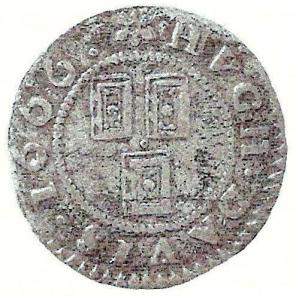
The obverse of a penny token of 1666 issued by Hugh Davies, Stationer at the sign of the Three Bibles in Holyhead, North Wales
The sign is first recorded in London in 1558 (15) and was later incorporated into the coat of arms of the Worshipful Company of Stationers. Putting the two component elements of Richard’s trade sign together we have Harp(er) the bookseller.
It has not been possible to precisely locate the original site occupied by Richard Harper’s shop in West Smithfield. However, its approximate location can be narrowed down from the description used in various of Harper’s publications, i.e. “near to the Hospital Gate in Smithfield”. The hospital in question is St. Bartholomew’s which in the mid-17th century still followed much of its medieval layout despite various expansions and alterations which commenced from the time of the re-foundation by King Henry VII. The original medieval hospital complex had four separate gates. These were the South or Tanhouse Gate, the Hartshorn or Giltspur Street Gate, the Little Britain Gate and lastly the Smithfield Gate (16). The latter appears to have been on the site of today’s King Henry VIII Gate which, in its present form, dates from 1703.
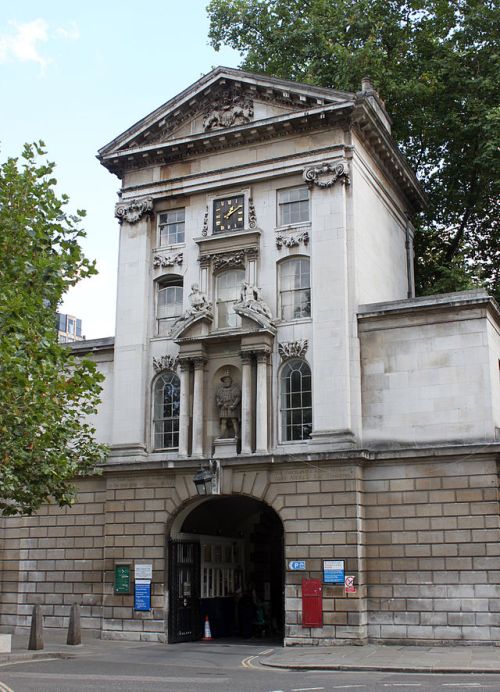
The main entrance to St. Bartholomew’s Hospital – King Henry VIII Gate built in 1702 on the site of the original West Smithfield Gate
It was near to this gate where Richard Harper’s shop was located. Presumably one of the buildings located on the east and west sides of the gate which fronted onto Smithfield. It appears that Richard Harper was not the only book seller in this part of West Smithfield at this time. There were several others (17)(18) ;
- Richard Burton (book seller) at the Hospital Gate, West Smithfield (c.1641-74)
- Henry Eversden (book seller) under the Crown Tavern in West Smithfield (c.1657-67)
- Thomas Lambert at the sign of the horseshoe near the Hospital Gate, Smithfield (c.1633-43)
- Andrew Sowle (printer) at Pie Corner, Smithfield
- John Oakes (printer) in Little St. Bartholomew, Smithfield (c.1636-44)
- James Crumpe (book seller and book binder) in Little St. Bartholomew’s Well Yard (c.1630-61)
- John Clarke (book seller) at the sign of the Fleur de Lys near the Hospital Gate in Smithfield (c.1654)
- Philip Brooksby (book seller) variously described as being next to the sign of the Ball or at the Golden Ball near the Hospital Gate, West Smithfield or at the sign of the Ball and Harp near the Bore Tavern, Pye Corner (c.1672-96)
Rounding the corner and going into Duck Lane and then Little Britain the concentration of book sellers and printers increased.
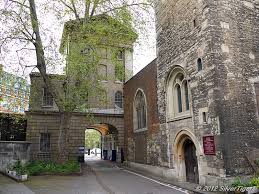
The rear of St. Bartholomew Hospital’s King Henry VIII Gate showing the west end entrance to the parish church of St. Bartholomew the Less
A list of annual rents paid on properties in the Parish of St. Bartholomew the Less in 1638 (19) indicates one for £1/10 on a property referred to as “Harpers”. Presumably this was Richard Harper’s book shop. Compared to other rents in this parish listing that paid on “Harpers” is of a comparatively very low sum. This possibly indicates it being a small and basic establishment.
From the triad of issuers’ initials on the reverse side of Richard Harper’s token we know that the Christian name of his wife began with “A”. A review of London parish registers and marriage records between 1620 and 1665 has indicated three possible matches the last of which happens to be in the same parish as Richard Harper’s bookshop;
1631: Marriage of Richard Harper and Ann Rickman at St. Anne Blackfriars
1634/5, 2nd February: Marriage of Richard Harper and Anne Hutton at St. Giles Cripplegate
1646; 19th May: Marriage of Richard Harper and Anne Walke at St. Bartholomew the Less
The last record of dated publications in the name of Richard Harper, from is shop at in West Smithfield, appears to be 1657. A review of Hearth Tax returns from 1666 for the parish of St. Bartholomew the Less indicates no tax payers by the name Harper. This may indicate that Richard had moved out of the area or had died. The latter appears likely as the burial register for the parish of St. Bartholomew the Less lists an entry for a “Richard Harper” on 14th March 1659.
While Richard Harper may have died whist still trading from his premises in West Smithfield the legacy of his shop, its trade sign of the Bible and Harp, and printed address of being near the Hospital Gate in West Smithfield continued under two successive publishers and book sellers, firstly John Clarke (c.1688-78) (20) (Note 1) and then James Bissel (1687-96) (21).
Notes:
- This is almost certainly the same John Clarke whose publications record his address as being at the sign of the Fleur de Lys near the Hospital Gate in Smithfield in 1654. It is also probably the same named person who paid Hearth Tax on a relatively small property (i.e. one having only two hearths) in the Well Yard of St. Bartholomew the Less in 1666 (22).
References:
- Arber, E. – A Transcription of the Registers of the Company of Stationers of London. 1554-1640 A.D. Volume III. (London, 1876).
- Ibid.
- Ibid.
- Ibid.
- Ibid.
- On-line data base entry in the British Book Trade Index (www.bbti.bham.ac.uk).
- Ibid [1].
- Berry, G. – Seventeenth Century England: Traders and their Tokens. (London. 1988).
- Plomer, H.R. – A Dictionary of Booksellers and Printers who were at work in England, Scotland and Ireland from 1641-1667. The Bibliographical Society. (London. 1907).
- Ibid [9].
- Smyth R. – Obituary of Richard Smyth, Secondary of the Poultry Compter, London: Being a Catalogue of All Such Persons as he Knew in Their Life: Extending from 1627 to A.D. 1674. Edited by Sir Henry Ellis, K.H. The Camden Society. (London, 1849).
- Ibid [1].
- Ibid [1].
- On-line basic search using British Library English Short Title Catalogue. (http://estc.bl.uk/).
- Lillywhite, B. – London Signs: A Reference Book of London Signs from Earliest Times to the Mid Nineteenth Century. (London, 1972).
- Power, Sir D’A. – A Short History of St. Bartholomew’s Hospital (Founded 1123) – Past and Present. (London, 1935).
- Ibid [9].
- Plomer, H.R. – A Dictionary of Booksellers and Printers who were at work in England, Scotland and Ireland from 1668-1725. The Bibliographical Society. (London. 1922).
- Dale, T. C. – The inhabitants of London in 1638. Edited from MS. 272 in the Lambeth Palace Library. Society of Genealogists. (London, 1931).
- Ibid [14].
- Ibid [14].
- Davies, M.; Ferguson, C.; Harding, V.; Parkinson, E. & Wareham, A. – London and Middlesex Hearth Tax. The British Record Society. Hearth Tax Series Volume IX, Part II. (London, 2014).
Acknowledgements:
The author gratefully acknowledges Patricia Fumerton (Director of UCSB’s English Broadside Ballad Archive) and Kate Jarman (Deputy Archivist, St. Bartholomew’s Hospital Archives & Museum) for information supplied during the research of this article.


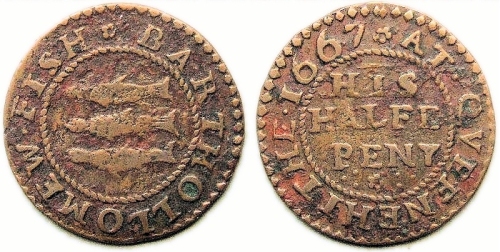
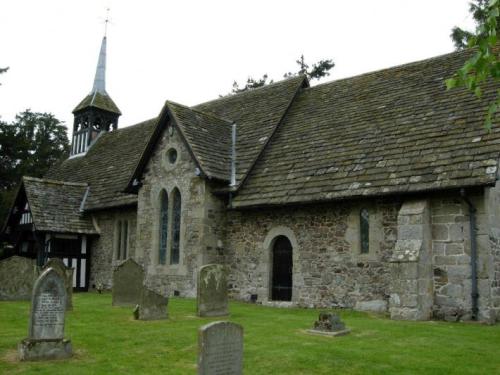


Another great post, brilliant
LikeLike
Thanks Jonas. I pleased you enjoyed the post.
While a few other London Stationers tokens are known this particular one has never been attributed to this particular trade before and as such is a first for Mr. Pepys’ Small Change.
LikeLike
Fantastic piece of original research, I take my hat off to you, proper research, well done.
LikeLike
Another great post – thoroughly researched, factual and well presented.
LikeLike
Thanks for your comments.
LikeLike